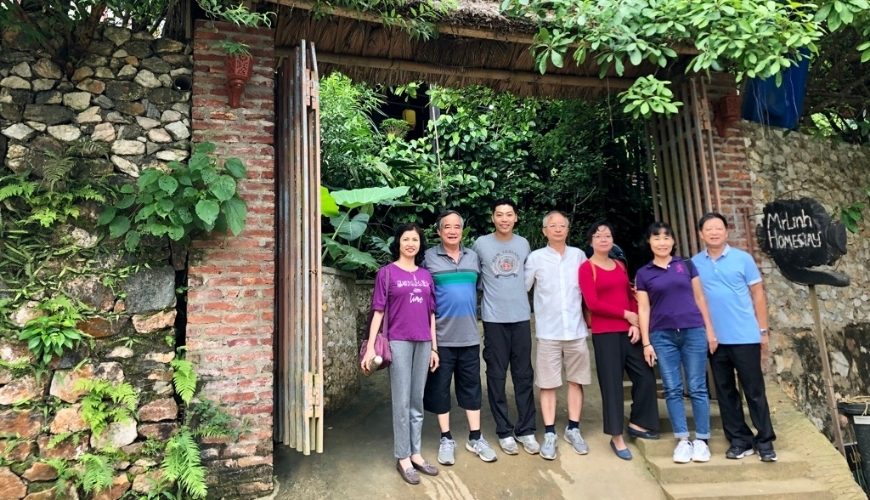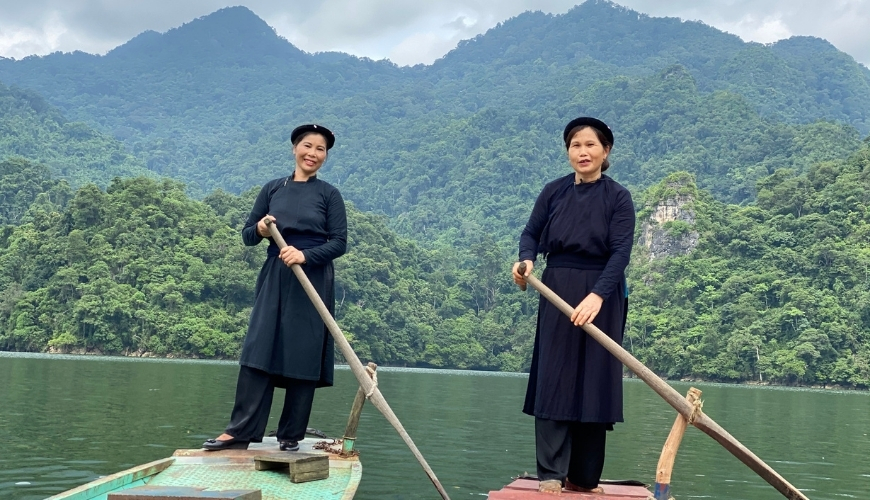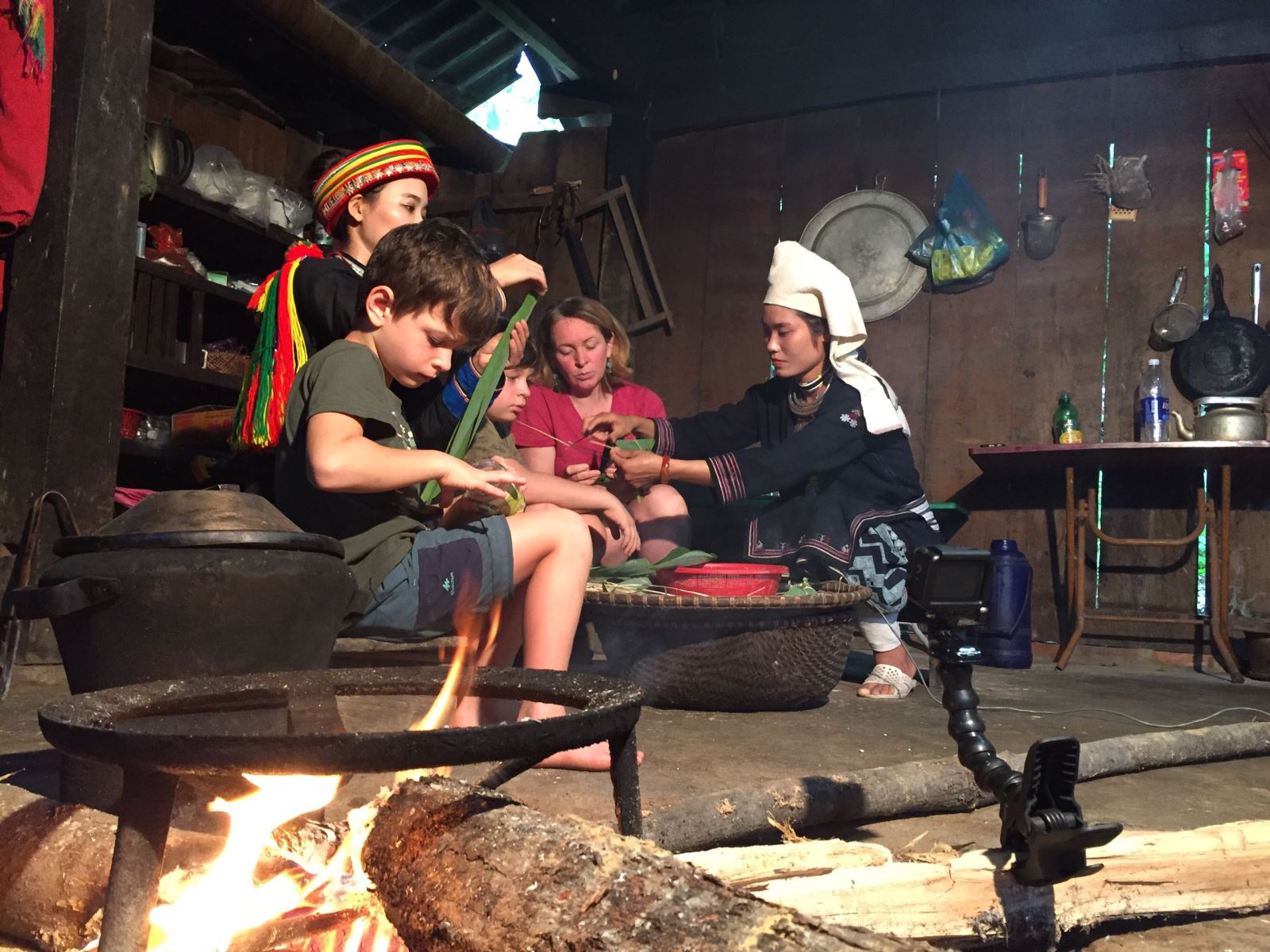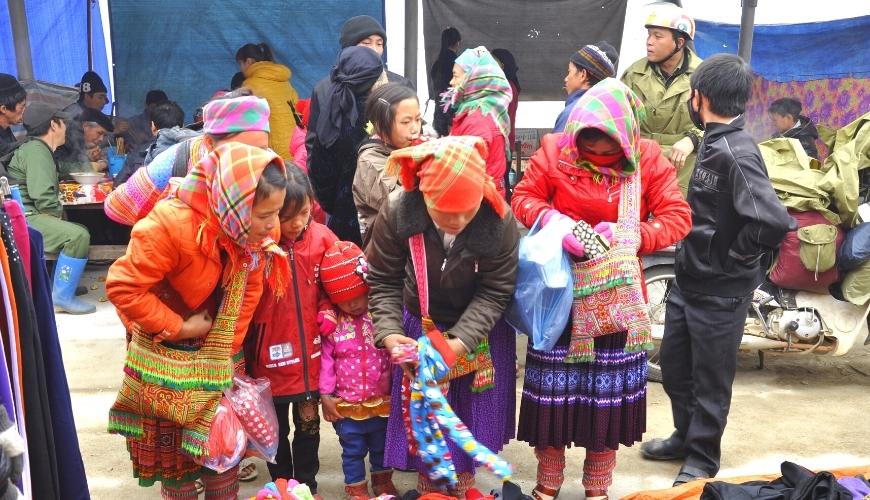
Ath the Mr Linh's homestay with some Viet King tourists
The Kinh are distributed throughout 61 provinces, with the largest concentrations located in the Delta and in urban areas. As the residents with the oldest indigenous traditions and history in Vietnam, the Kinh settled and developed in the Northern and North-Central regions of the country. Throughout Vietnamese history, Kinh has always been at the centre of the country, whether it’s economically, culturally, or in building a trans-ethnic Vietnamese identity.
Economically, the Kinh has known metallurgy since ancient times, crafting tools of iron, copper and copper alloys. The emergence of iron-working, the Kinh people laid the foundations for ancient Vietnamese civilization. Sustaining themselves with wet rice agriculture, the Kinh successfully exploited the fertile plains, and developed a rich culture of traditional arts and crafts. Kinh economy was already thousands of years old by the time modern and colonial times began, and is still primarily an agricultural focused economy supplemented by traditional craftsmanship and exports.
On the subject of social organization, after the Kinh emerged from the caves, they settled in clustered villages composed of several “hamlets” that each functions as an independent village but in conjunction and symbiosis with each other. Every village has a communal house where all the residents from the different hamlets can come to worship.
Unlike some other ethnic groups in Vietnam, the Kinh live on the ground. The main structure of a house is usually 3 or 5 spaces with the middle space being the most important one, as it contains the altar.
Culturally, the Kinh are unique, having incorporated a host of successful aspects of other cultures throughout history. The culture is incredibly diverse, which is represented in religious beliefs, with the Kinh adhering to Buddhism, Confucianism, Taoism, Catholicism and others. These imported beliefs have been moulded and altered to better fit with Vietnamese life and culture. Ancestral worship is the most important cultural belief among the Kinh, with all homes containing an altar to venerate those who came before, also serving as a central aspect of rituals and celebrations.
The literary and artistic culture of the Kinh has gone through continuous development over thousands of year, with a rich heritage of folk art such as fairy tales, folk music, proverbs and others. A drastic increase in folklore literacy among the Kinh has greatly aided in both preservation of their heritage as well as in crafting and strengthening a common national identity. For literary writing, the greatest works were written during the Ly-Tran period, especially from the 15th century and onwards, featuring works by literary geniuses like Nguyen Trai, Nguyen Du, Ho Xuan Huong, etc.
Tay Ethnic Group

The Tay ladies
With around 1.7 million people, the Tay are the biggest ethnic minority group in Vietnam. They live mainly in Vietnam’s northern and northwestern provinces - Cao Bang, Bac Can, Lang Son, Ha Giang, Thai Nguyen, and Lao Cai. They live along rivers in mountain foothills.
The Tay build their villages in valleys, on mountainsides, or in the highlands. A Tay village has from 20 to over a hundred households. They live in wooden stilt houses with tile or palm leaf roofs.
Both men and women wear clothes made of hand-woven cotton, dyed with indigo. Women wear high collared, waist- or knee-length shirts buttoned on the right side. Their pants have roomy legs and a wide belt. Tay women enjoy wearing jewelry, particularly silver necklaces and arm and wrist bracelets. Men’s clothing is similar to that of women. Hoang Thi Xoan, a white Tay woman in Xuan Giang commune, Ha Giang province, said: “The Tay include black Tay, white Tay, and Thai-Tay branches. We identify each other mainly by the color of our costume. The white Tay wear indigo headscarf, shirt, pants, and belt. The black Tay wear a black shirt and long dress. We all wear silver necklaces. The white Tay make up 80% of the population in Xuan Giang. The black Tay live in Xin Man, Ha Giang province.”
Like many other Vietnamese ethnic groups, the Tay practice polytheism and believe that supernatural powers have impacts on their life. Worshiping their ancestors is the most sacred ritual of the Tay. The ancestral altar is placed in the center of the house. In front of the altar is a bed on which visitors are not allowed to sit or lie. The Tay have many taboos, like: people may not step on the edge of the stove, after attending a funeral people must take a bath before tending the cattle and poultry, and new mothers are not allowed to stay near the altar.
Every Tay house in Lang Son has a stone dog at the gate. The Tay believe the stone dog will help the owners take care of the house and chase away bad luck. Vy Van Co of Loc Binh, Lang Son province, said: “Our ancestors told us that if the house is built on hard soil or if the house faces a bad direction, a brook, a lane, or a hill, we should place a stone dog at the gate to protect the house and its contents, preserve peace, and promote production. The stone dog will inform our ancestors of any evil coming to our house.”
The Tay have developed a rich culture of poems, songs, epics, tales, funny stories, and dance. Popular folk singing genres of the Tay are call-and-response singing, lullaby, Then, and wedding and funeral singing. Then is sung at events such as worshiping at the ancestral altar, praying for sick people, praying for a couple to have children, at family get-togethers, to welcome guests, and at a “going to the field” festival held in the first month of the new year. Then is an indispensable part of the spiritual and religious life of the Tay.
Dao Ethnic Group

Dao ethnic group
The Dao originated in China, before moving to Vietnam starting in the 12th century, and lasting until the first half of the 20th century. Dao people usually live on the mountain slopes in the Northern provinces, however a group of white pant Dao live down in the valleys, and Red Dao live high up on the mountain peaks.
Hamlets usually consist of five to seven scattered houses, and the building style can vary greatly depending on where they live, ranging from huts on the ground to houses set on stilts.
The primary economic activity is farming, with the cultivation methods again varying depending on location. The White Pants Dao, Long Shirt Dao and Thanh Y Da specialize in wet fields, while the Red Dao specialize in dry fields. The remaining Dao groups either do a combination of these or sedentary cultivation raising cattle, pigs, and chickens, as well as goats and horses in the mountains. Cultivation of cotton and the weaving of fabrics is also important to their daily life and their signature cloth is dyed indigo. Most villages also have a blacksmith which can even create their own type of flintlock weapon! There are also some silversmiths, though this is an hereditary occupation.
Traditionally, men would have long hair kept in a bun, and shaved around. They different groups would also have traditional turbans, and two types of shirts (short and long sleeves). Women dress meanwhile is very diverse, normally consisting of long robes, bibs, skirts and pants. Clothes are generally colourful, and according to Dao customs, they will hang green leaves or banana flowers above doors during childbirth, this protects the soul of the child from evil spirits. During weddings, the families will sing, and the groom comes to the bride’s house to “kidnap” her, carrying her back to his family home.
In terms of religion, the Dao believe in folk beliefs, agricultural rituals and have deep influences from Confucianism, Buddhism and Taoism.
The generations that constructed a village are considered the original ancestors of a Dao community, and are worshipped together with individual families’ ancestors. The Dao also has a rich history of folk art, including the famous stories of “Gourd with Deluge” and “The history of the primitive ancestors”.
►
Read also : The Dao of Ba Be: A People, a Culture, a History
H’mong Ethnic Group

Hmong ethnic group on the day market at Ba Be
H’mong people are concentrated in the mountainous provinces of Cao Bang, Ha Giang, Lao Cai, Lai Chau, Son La, Tuyen Quang, Yen Bai, Thanh Hoa and Nghe An. Their economy mainly depends on shifting cultivation or sedentary cultivation and terraced fields of maize, wheat, and barley. Additional occupations include growing flax, opium cultivation (previously), and fruit trees such as apples, pears, peaches, plums and weaving linen. The Hmong mainly raises cattle, pigs, chickens, and horses, with the horses are very close to each Hmong family.
Markets in the H’mong areas satisfy both the need to exchange goods, as well as social and cultural activities. H’mong costumes are colourful and varied among the groups, and the different groups can be distinguished by the colour of their women’s clothing:
- White Hmong women wear white dresses, a shirt with a rip on chest and embroidered patterns in the sleeves, back bibs, shaved hair with a cap and wear turbans with wide brims.
- Flower Hmong women wear indigo skirts embroidered with floral motifs or printed flower made of wax, with underarm rips, shoulders and chest covered by coloured fabric and embroidered.
- Black Hmong women wear skirts of indigo cloth, with printed patterns of wax with chest rips.
- Blue Hmong women wear tube skirts.
- When Green Hmong women marry, they place their hair in a bun, with horseshoe combs and cover a turban to form into two horns.
The H’mong places great emphasis on respecting your family, including those who have common ancestors. Each family’s typical characteristics are shown in ancestor worshipping rituals such as “door ghost” or “midwife ghost”. People who have the same ancestors are prohibited from getting married. Emotion among people in the same family runs very deep and the head of the whole family has prestige and is respected and trusted. During weddings, the bride will be collected from her family home and carried to her groom’s house. Spouses are close, usually visiting the market together.
In terms of worship, the various house spirits take centre stage, for example the “House Ghost”, the “Kitchen Ghost”, and the “Door Ghost”. The traditional H’mong holiday is in early lunar December, which includes climbing activities, music and dancing.